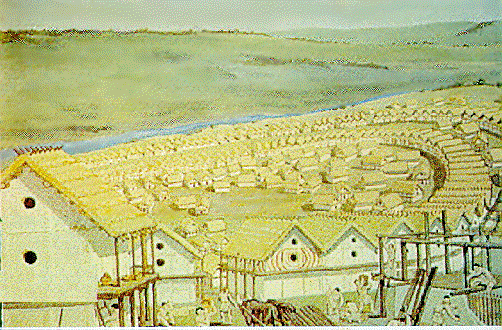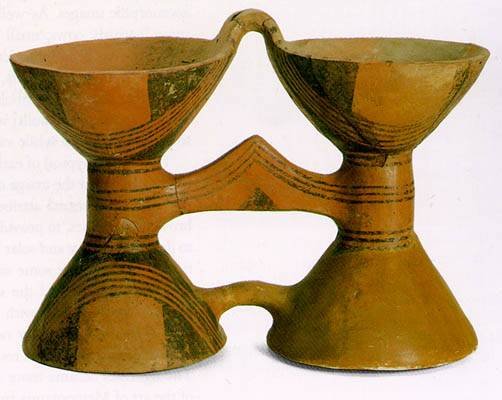|
Trypillian Civilization Tour |
|||
|
About Trypillia - 4 |
|||
| +++ | |||
|
By Dr.Mykhailo Videiko, Institute of Archaeology, NAS of Ukraine. Strange things are found in the European legends of the Copper Age: they claim, that on the end of the World there is a River of the Dead on the other side of which the World of the Dead begins. Above it stands Tavropolis - literalle Bull City, guarded by the monsters responsible for carying the souls of the dead to the World of the Dead. Thus through historic memory some evidence on the existence of the city in Europe in the V-IV milleniums BC has survived! It's worth searching for this city somewhere along the border between a forest and a steppe, in so far as European farmers used to regard steppe land as the "other world" since it was impossible to grow bread here and live normally. In the center of the modern Ukraine from the East to West the Sinyukha river flows, which the Scythians used to call "the Dead Water" 2500 years ago. Could it be the River of the Dead? But where was the ancient Tavropolis? Where are its ruins? It should be older than Sumerian Ur and Babylon. But it is difficult question to answer not so much because Ukrainian antiquties from 5000 years B.C. have been lost, but on the contrary too many have survived. 30 years ago there was a discovery, whose importance still has not been fully realised. As a result of the aerial photography in the Ukrainian forest-steppe not just a city, but several dozen cities of the Copper Age were discovered. The smallest of them occupies an area of 0,4 square kilometer, and the biggest one-near 4,5 square kilometers. The famous Ur in Mesopotamia at the beginning of the 3-rd millenium B.C. occupied near 0,9 sq.km... The first reaction of the archaeologists somewhat skeptical, sometimes negative: "it can't be so, because it's simply impossible". But some years later, thanks to magnetic survey, it was even possible to make exact plans of mysterious proto-cities. After this even the most ardent skeptics were convinced that gigantic settlements were not a figment of imagination, but unknown page of European prehistory. What kind of people lived here? Archaeologists called this antiquities "The Tripolye (Trypillia) culture". The Western part of this cultural complex is better known as the Cucuteni culture. Influence of this ancient civilizations 6000 years ago stretched from the modern Rumanian Prykarpattya in the West to the Dnipro (Dneper) river in the East. Now it is the territory of Romania, Moldova and Ukraine, the peoples of which have inherited some elements of these ancient civilization.
New excavations of Ukrainian archaeologists made it possible to restore some of these proto-cities. The Trypolians built comfortable houses of materials that where easy to obtain - clay and wood. The buildings of settlement near Maydanetz consisted of 2-storey "cottages", each with a floor area from 70 to 200 sq.m or more. The first floor was used for home management and the second - for living. Nearly every family owned such a house. Clay models of houses which were found during excavations often depict 2-storey buildings with vertical pillars, breast walls, a rounded window, doors and threshold. During these ancient times every city had to be a mighty fortress. The houses of Tripolye proto-cities were built closely one to another, like terraced houses, making up at least two lines of fortification. The first line occupied the center, and the second one was on distance equivalent to the flight of an arrow from the first line. The scale is extremely impressive: the elliptical form of the citadel of Maydanetz was 1 km long and that of Tallyanki - 3,5 km long! On the magnetic plans and aerial photographs of settlements we also can see additionally fortified estranges. Further investigations should show what the gates of the legendary Tavropolis looked like.
Tripolye proto-city Maydanetz - scientific
reconstruction. The beauty of Tripolye culture lies in its pottery and clay sculpture, whose perfection cannot fail to impress you. The pottery used to be fired two-tiered furnaces, then painted, carved and encrusted. The whole world outlook of the prehistoric farmers was expressed in the ornament: the land and underground world, the sky, the sun, the moon, the stars, the plants, animals and people. The ancient paintings speak to us from the depth of centuries a forgotten language much as their creators once addressed gods, now forgotten. Only they, old gods of Europeans understood this language of symbols and signs.
Observant people can see complete "texts" composed in ornaments: it is raining, the grain is falling on the ground, it is sprouting, the ears of the cornfield are turning toward the moisture of the sky... only the step remained before the creation of own system of written language. Among the Tripolye symbols are more than 300 different symbols and their blocks. Among them are some, known to ancient Sumerians: "the star of Ishtar", "house","barley" and other. But the Tripolye civilization disappeared before the system was turned into a written language. The Tripolye plastics arts, namely portrait sculpture, are unique masterpieces. Though 55 centuries we are looked at by women - old and young, with narrow of broad faces and sophisticated haircuts; by solemn men, with beards and shaven heads, big noses and wide-spread eyes.
The civilization of Tripolye fascinates and attracts your attention the more
and more is discovered about it. It still holds many secrets, but one thing is
clear enough: the history of European civilization began at the time, when the
red walls of Tavropolis were rising over the River of the Dead, when people
learned to bake bread and smelt metal on the land, now called Ukraine. This article is published here by permission from Dr. M. Videiko |
|||
|
Copyright © 1999-2002 Kolos Corporation |
|||







